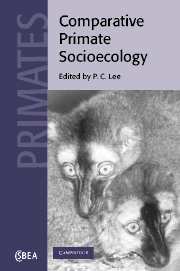Book contents
- Frontmatter
- Contents
- List of contributors
- Preface
- Part 1 Comparative methods
- Part 2 Comparative life history and biology
- 4 Socioecology and the evolution of primate reproductive rates
- 5 Comparative ecology of postnatal growth and weaning among haplorhine primates
- 6 Some current ideas about the evolution of the human life history
- 7 The evolutionary ecology of the primate brain
- 8 Sex and social evolution in primates
- 9 Mating systems, intrasexual competition and sexual dimorphism in primates
- Part 3 Comparative socioecology and social evolution
- Editor's conclusion: Socioecology and social evolution
- Index
8 - Sex and social evolution in primates
Published online by Cambridge University Press: 24 August 2009
- Frontmatter
- Contents
- List of contributors
- Preface
- Part 1 Comparative methods
- Part 2 Comparative life history and biology
- 4 Socioecology and the evolution of primate reproductive rates
- 5 Comparative ecology of postnatal growth and weaning among haplorhine primates
- 6 Some current ideas about the evolution of the human life history
- 7 The evolutionary ecology of the primate brain
- 8 Sex and social evolution in primates
- 9 Mating systems, intrasexual competition and sexual dimorphism in primates
- Part 3 Comparative socioecology and social evolution
- Editor's conclusion: Socioecology and social evolution
- Index
Summary
Introduction
Life history and male infanticide risk
Infanticide by males unlikely or unable to have fathered a female's current dependent offspring is an adaptive male reproductive strategy if the mother can soon be fertilised again and the infanticidal male is in a position to be the likely sire of her next infant (Hrdy, 1979; Hrdy, Janson and van Schaik, 1995). It is remarkably common among primates (Hausfater and Hrdy, 1984; Struhsaker and Leland, 1987; Hiraiwa-Hasegawa, 1988). Its importance as a source of infant mortality probably varies widely, but it is estimated to be responsible for 31–64% of all infant mortality in some well-studied species (hanuman langurs: Sommer, 1994; Borries, 1997; mountain gorillas: Watts, 1989; red howlers: Crockett and Sekulic, 1984). Several detailed studies have demonstrated that it is an adaptive behaviour for males (op. cit.; Hrdy, 1979).
Male infanticide is potentially common in primates because many species have prolonged lactational amenorrhoea. In species without lactational amenorrhoea, early resumption of mating activity (‘postpartum oestrus’) means that killing infants will not advance the female's next birth. The incidences of postpartum mating and lactational amenorrhoea, in turn, are determined by the relative length of gestation and lactation. Where lactation is longer than gestation, we find lactational amenorrhoea, in both primates and other mammals (van Schaik, in press).
Among primates, there is a strong relationship between the mode of infant care, the incidence of postpartum mating and the incidence of male infanticide.
- Type
- Chapter
- Information
- Comparative Primate Socioecology , pp. 204 - 240Publisher: Cambridge University PressPrint publication year: 1999
- 95
- Cited by



